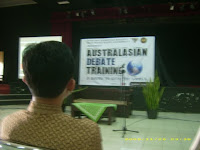It was cloudy and gloomy Sunday, but we forced ourselves leaving our beloved bed early in the morning to attend Australasian Debate Training (ADT). The training was held by English Debating Society (EDS) of UNNES and we registered there for the sake of improving our debate technicality. B6’s ball room was occupied by around a hundred of participants from UNNES and of course three musketeers from LCDC. We passed the stuffy registration desk to enter the room to get convenient row in front. Luckily the two rows in front were exactly for three of us, without any purpose. For that reason, we started believing that it was going to be a great day. (insert picture; ADT-1)
A debate simulation performed by EDS committee opened the first agenda of ADT. The audience watched the show speculating matter, manner and method including the three of us. Some of the audience did not know what to do, some were playing with their phones, some widened their eyes figuring words by words and few people made notes. These people were fortunately the three of us. Then, Mr. Hendy Pratama—the funny boy, as the audience named him—delivered Australasian Debate Technicality, and it was all about procedures in debating that people should know. Technicality represented “what” to debate. We brainstormed and learned some terms about it. It was fun presentation; three of us and all audience were entertained by his jokes, anyway. Some slides of EDS program and songs closed the presentation, and here came the lunch time. We took our lunch box and chatted for a while. Going outside the room was not preferable because of the drizzling rain. (insert picture; ADT-2 )
)
 )
)
After feeling full, we were ready to follow the second session of the training. It was about argumentative-kick starts in debate and adjudication (they way debate is assessed). The presentation discussed a lot about philosophical side of debate (this is about “why” we debate) and how the team direct the motion into a good debate. Mr. Aditya Rakhman delivered it gravely. It was contradictive to the first speaker. Yet, his points of view were very interesting, because if we could master all his suggestions we would have bigger possibility to win the debate. He was the winner of national debate championship for several times. Viewing the motion—which turns to be either philosophical or propositional—is urgent to direct our critical thinking in debate then to win the debate itself. “Practice makes perfect” as what he suggested. The cool weather made sweet impression on us; even we did not realize that it was coffee break time. We had a break and enjoyed the coffee and snacks. One of us, Dani, became one of the participants for debate simulation session. So, he had to prepare the case, right after he finished his coffee. (insert picture; ADT-3)
The chairs were set by the committee. Three for the affirmative team at the right side of the audience, three chairs in front were for negative team, and in the middle three were for the adjudicators. The debate simulation would soon start. There were only half of audience decided to stay during the simulation, it might be because they were tired and they felt it was too hard for them to follow or to stay until the show ended. “This house would criminalize unregistered marriage (nikah siri)” that was the motion for the debate simulation. The debate was challenging, Dani tried his best playing his role as the second speaker of affirmative team. We at the audience side hesitated Dani’s group victory, yet the minutes kept running. The adjudicator announced the winner, and it went to Dani’s group. That made us happy, it was great job for affirmative team, we were proud of having Dani in affirmative team then finally he won the case.
At last, the seminar was over, we took some pictures. Overall, it was great, we learned some new terms, knowledge and experience. Some knowledge that we got from the seminar will surely be shared to others—especially LCDC members. We hope we are still able to participate in similar seminars or competition in the near future. For that reason, we suggest that all LIA students, who have great motivation and vision to be great speaker, will join LCDC and improve their English and public speaking skill. (insert picture ADT-4)



